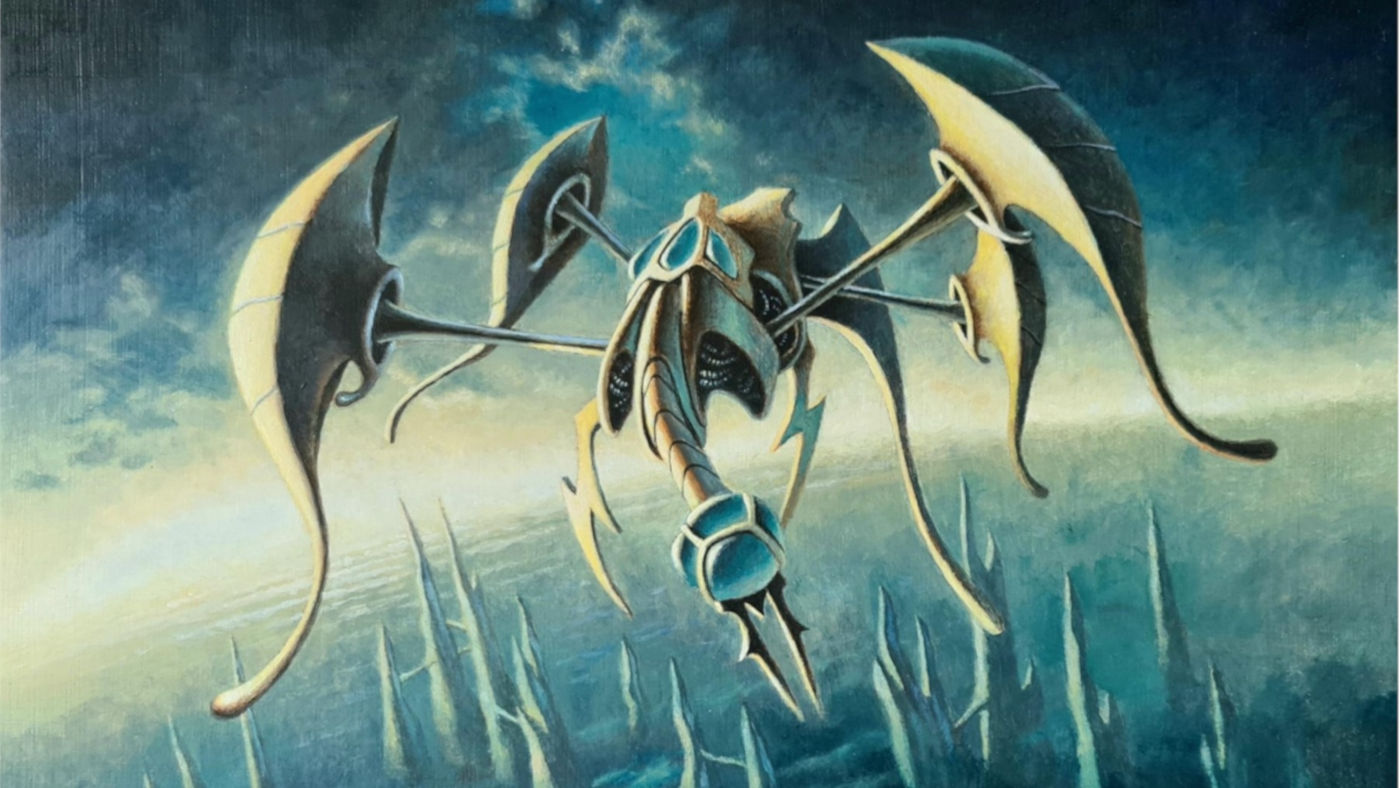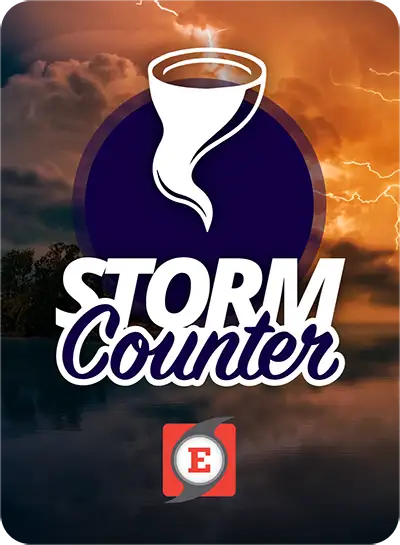1. What is 8-Cast?
8-Cast is the evolution to one of the scariest matchups for The EPIC Storm: Karn Echoes. Both are mono-blue artifact decks that play [[Force of Will]] and [[Chalice of the Void]]. Karn Echoes also played [[Karn, the Great Creator]], which is nearly unbeatable in play and was more all in on the combo of [[Lion’s Eye Diamond]], [[Echo of Eons]] and [[Hullbreacher]] to lock opponents out of the game quickly. 8-Cast eschews some of the combo nature of Karn Echoes and plays more fair cards like [[Thought Monitor]] and [[Thoughtcast]] (hence the eight “casts”). It relies much less on the prison element and sometimes does not even play the full four copies of [[Chalice of the Void]]. Instead, 8-Cast plans to overwhelm fair decks with the velocity at which it cycles through its deck while creating value with cards like [[Sai, Master Thopterist]].
2. How does 8-Cast beat The EPIC Storm?
In game one, 8-Cast has two main interaction points for The EPIC Storm in four copies of [[Force of Will]] and three to four copies of [[Chalice of the Void]]. Other than those cards, most of the cards in 8-Cast are just creatures that attack or cards that draw more cards. One thing to note is there is almost always a main deck copy of [[Pithing Needle]]. [[Pithing Needle]] naming [[Wishclaw Talisman]] can be devastating to certain hands and 8-Cast has effectively five copies of [[Pithing Needle]] due to [[Urza’s Saga]]. This can speed up the game quite quickly as 8-Cast can play [[Urza’s Saga]] on turn one and start pumping out constructs quickly while slowing TES down. In post-board games, there are four copies of [[Force of Negation]] that they bring in to attempt to fight through their combo matchups.
3. How does The EPIC Storm beat 8-Cast?
Of the turbo blue artifact decks that have existed over the past few years, this might be one of the better matchups for TES. 8-Cast not having [[Karn, the Great Creator]] or a faster combo lock kill is positive for TES. This is a match up that almost completely revolves around [[Chalice of the Void]] on one. Because [[Chalice of the Void]] on one stops cards like [[Veil of Summer]] and [[Silence]], which means their copies of [[Force of Will]] will always be live. In game one, the best way to attack this is to jam. Playing a long game with this deck is not good and being able to win the game before they can convert their cantrips into real cards is essential. Because they only have four [[Force of Will]] effects in game one, they are unlikely to have one in their opener on average. Taking the 60 percent to win the game before their engine gets online seems like the best plan. Winning quickly in this matchup also means aiming for [[Ad Nauseam]] over [[Echo of Eons]]. Passing the turn after a mediocre [[Echo of Eons]] can be dangerous as giving the opponent that much velocity to be able to build an unbreakable hand can lose the game on the spot.
4. How does Chalice of the Void affect the matchup?
[[Chalice of the Void]] is always a card that is effective against TES. The dynamic of the card in this matchup is interesting because [[Chalice of the Void]] is also good against 8-Cast. [[Chalice of the Void]] on zero tends to be the most effective number against TES because it turns off all of the artifact mana. [[Chalice of the Void]] on zero also locks the 8-Cast player out from being able to churn through all of their cards. Additionally, [[Chalice of the Void]] on zero also presents the TES player with the opportunity to answer it through [[Veil of Summer]], given the card double duty against [[Force of Will]] and [[Chalice of the Void]]. [[Chalice of the Void]] on one is a completely different situation and is the main reason that this matchup is not good. It stops all of the cantrips, rituals, and protection spells. Normally in [[Chalice of the Void]] matchups, preventing the TES player from casting [[Veil of Summer]] does not matter that much because the [[Chalice of the Void]] player does not have counter magic. Against 8-Cast, ensuring that their [[Force of Will]] effects are always live is perhaps the most powerful part of the card, as it is possible to go off through a [[Chalice of the Void]] on one. This is why most plans need to account for TES not being able to interact with the 8-Cast player on the stack.
5. How does The EPIC Storm sideboard in against 8-Cast?
In the past, the focus has been on removing some of their lock pieces and hoping to dodge a [[Force of Will]] or two against other blue artifact decks. With 8-Cast having eight copies of [[Force of Will]] effects, this is not a viable plan. Removing a [[Chalice of the Void]] with [[Prismatic Ending]] is powerful, especially given that it cannot then be recurred by [[Emry, Lurker of the Loch]]. However, [[Prismatic Ending]] is just so unlikely to resolve. Attempting to out grind 8-Cast by forcing them to two for one themselves over and over again is not a viable plan because they can recover that card advantage pretty easily through all of their [[Thoughtcast]] effects. Going under their card advantage is not a viable strategy either because of their high [[Force of Will]] count. This means that a viable plan is to attempt to grind with them. The grind plan of [[Galvanic Relay]] lines up well against what 8-Cast is trying to do. It is able to go around all of their [[Force of Will]]s and can go through [[Chalice of the Void]]. [[Galvanic Relay]] tends to also be a faster engine than their ability to chain [[Thoughtcast]] into [[Thoughtcast]].
6. What is the sideboard map against 8-Cast?
-4 [[Ponder]], -1 [[Echo of Eons]], +3 [[Galvanic Relay]], +2 [[Abrupt Decay]]
One might notice that this is the same mapping as against fair blue control decks! Intuitively, this may be weird at first, but in abstract terms, fair blue control and 8-Cast have similar make ups post board: lots of counter spells, some card advantage engines, and a couple of lock pieces. The main difference is that [[Chalice of the Void]] is stronger than something like [[Ethersworn Canonist]] because it shuts down all of TES’s protection spells.
7. How does The EPIC Storm approach the matchup?
Despite the mapping being similar to that of a blue control deck, the types of hands that are keepable are different. A slow hand with some lands, cantrips, and mana might be keepable against blue control, but it is not against 8-Cast. A good hand against 8-Cast aims to go off on turn two or turn three with either [[Abrupt Decay]] or a protection spell. [[Abrupt Decay]] can be slightly awkward in this match up due to [[Emry, Lurker of the Loch]]. Allowing the opponent to replay a [[Chalice of the Void]] is powerful for them and not good for the Storm player. Because of this dynamic, [[Abrupt Decay]] should be used more like a bounce spell rather than a removal spell. Keeping a five or six card hand that revolves around [[Galvanic Relay]] is likely good enough. Chaining [[Galvanic Relay]]s is the best way to win the matchup.
8. Should The EPIC Storm play Pulverize?
No.
Really, this matchup is not about removing all of their permanents. [[Pulverize]] would often be equivalent to [[Prismatic Ending]] in that they are both answers to [[Chalice of the Void]] that can be found from [[Burning Wish]] and can be countered.










